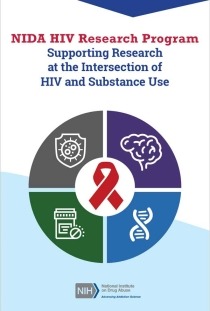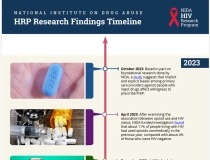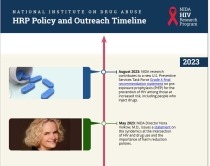What We Do:

NIDA's HIV Research Program (HRP) supports the development, planning, and coordination of high priority research at the intersection HIV/AIDS and substance use disorders within NIDA, NIH Institutes and other DHHS agencies.
History
NIDA created its AIDS Research Program in 2004 to explore the complex intersection of HIV/AIDS and substance use disorders. The program includes research into the increased vulnerability to the immune system brought by chronic exposure to addictive substances; the HIV risks associated with injection drug use; and prevention of risky behaviors linked to impaired judgment that have historically been part of the HIV transmission cycle.
Nearly two decades later, the AIDS Research Program has become the HIV Research Program. In this time it has grown into a substantial portion of NIDA’s mission, resources, and research portfolio, overseeing interdisciplinary initiatives and critical funding opportunities that have advanced the field.

To highlight our accomplishments, NIDA has created two graphic timelines - one timeline identifies some of our high impact research findings related to the crossroads of HIV and substance use (PDF, 930 KB), and the other identifies key policy and outreach milestones (PDF, 903KB). These timelines not only reveal a history of program accomplishments but also forecast future achievements in research.
NIDA HIV Research Priority Areas
To support research at the intersection of substance use, HIV, and related comorbidities and generate evidence-based strategies to improve individual and public health:

- Prevent new infections and transmission of HIV among people who use drugs and their sexual and/or injection partners.
- Increase understanding of etiology, pathogenesis, spread, and persistence of HIV/AIDS among people who use drugs.
- Address comorbidities and improve health outcomes among people living with HIV who use drugs.
- Accelerate scientific discoveries in HIV/AIDS and substance use research.
See also:
- NIH HIV/AIDS Research Priorities Webinar and FAQs (4/21/16)
- NIDA HIV Research Program Update: High Priority Research Areas - Council Presentation from 9/5/19, (PDF, 2.82 MB)
Funding Priorities
- Fiscal Year 2018 Funding Priorities (PDF 342KB)
- NIH HIV/AIDS Research Priorities and Guidelines for Determining AIDS Funding - NOT-OD-15-137
- Statement on NIH Efforts to Focus Research to End the AIDS Pandemic , NIH Director, Dr. Collins (8/12/15)
Research Resources
Training Opportunities
- Research Training & Career Development
- Minority Training Programs - Office of Diversity and Health Disparities (ODHD)